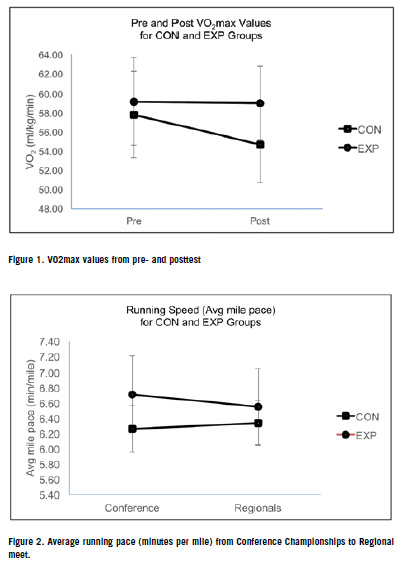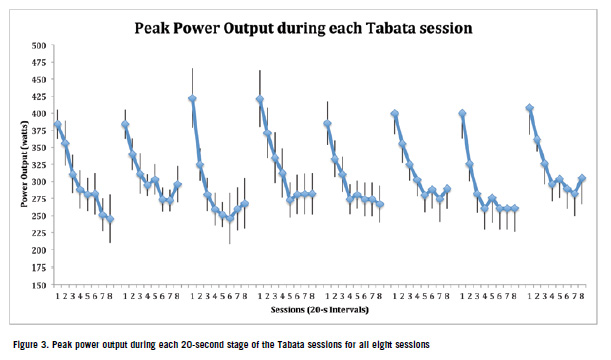| Sprint-Interval Cycling Training - The Effect of Tabata Protocol on Collegiate Level Distance Running |
| By: Brandon Chapoton
Originally Published in: Techniques Magazine Provided by: USTFCCCA When studying the growth of marathon participation, Fredericson and Misra (2007) found that a sudden increase in running volume, especially above the 40 miles per week threshold, is one of the strongest independent risk factors linked with running injuries.1 Studies have shown that short-term sprint interval training (SIT) and high-intensity interval training (HIIT) protocols have the ability to improve health-related indices, including cardiorespiratory fitness and markers of glycemic control in healthy individuals.2 It has also been recognized that relatively short-term SIT and HIIT protocols can rapidly enhance aerobic capacity metabolism and elicit certain remodeling of the physiological system similar to that of moderate intensity continuous training (MICT).2 Some of the current research trends are aimed at the physiological improvements that occur in moderately trained (avg. 25 miles/week), older individuals.3 One study found that after two-weeks of HIIT training there were no significant improvements on VO2max for any of the groups tested.3 While others have found that high intensity SIT provides increases in VO2max that are commonly associated with exercise at moderate intensity over long periods of time.4 Then there are those that found moderate improvements of VO2max, but nothing significant.5 After seven sessions of SIT, it has been shown that there is a decrease in maximal heart rate during moderate intensity exercise.6 When previous studies were conducted, participants weren't asked to continue their running or training outside of the testing performed. Therefore, we will conduct a study on collegiate level distance runners utilizing the Tabata protocol four times a week for two weeks, while still allowing the participants the ability to run a set amount of mileage a week (40 vs. 60 miles). The purpose of this research experiment was to determine whether Tabata training on a cycle ergometer four times a week for two-weeks would help maintain cardiorespiratory fitness in collegiate level distance runners. It was hypothesized that substituting 20 (M) and 15 (F) miles in a trained cross-country runner's weekly training with 4 sessions of Tabata on a cycle ergometer for two weeks would maintain VO2max. METHODS Experimental Approach to the Problem All student-athletes (SA) completed a preliminary session. The preliminary session consisted of an assessment of cardiorespiratory fitness and anthropometric measurements. The SA were then randomized into two separate groups, an experimental (EXP) and a control (CON) group. The EXP group completed eight sessions of a Tabata while the CON group only participated in running activities throughout the length of the study. After, there was one final session in order to measure VO2max post intervention. A certified athletic trainer was present at all sessions.
Participants The participants were 10 NCAA Division I cross-country runners (n=10, male=5, female=5). All SA provided written informed consent before participation and completed a medical history questionnaire. In order to participate in collegiate athletics, the SA had been previously cleared with a team physician at the start of their season. SA were randomized into two groups (n=5 EXP, n=5 CON). The SA were EXP=19.33±1.03, CON=19±1.41 years old, with an average height (in cm) of EXP CON=58.28±8.21. All athletes were given specific instructions based on which group they were in. Due to sample size, the men and women were grouped together. Preliminary Session All sessions were conducted in the Southeastern Louisiana University Exercise Physiology Laboratory. The pre-liminary session consisted of anthropometric measurements and a VO2max test. Anthropometric measurements included height and weight using a stadiometer, blood pressure measured using a sphyg-momanometer and stethoscope, and resting heart rate using Polar® WearLink® coded HR monitor and FT7 watch (Polar Electro Inc., Lake Success, NY). In order to determine base VO2max, the Ellestad protocol was used.7 The test was completed on a Cardiac ScienceTM Quinton® Q Stress® TM 65 treadmill (Mortara Instrument, Inc., Milwaukee, WI). During the test, VO2 was measured using the Parvo Medics' TrueOne® 2400 metabolic analysis system (Parvo Medics, Sandy, UT), and heart rate was monitored using the aforementioned heart rate monitor. The test started with a three-minute warm up at 1.7 mph and 10% grade. Stages 2-8 were each two minutes long. Stage 2 was at 3.0 mph and a 10% grade, stage 3 was 40 mph at a 10% grade, and stage 4 and 5 were both at 5 mph, with grades of 10% and 15% respectively. Stages 6,7, and 8 were completed at a 15% grade and at 6.0 mph, 7.0 mph, and 8.0 mph, respectively. The test was completed when the SA reached exhaustion. A heart rate close to 200 bpm or the SA felt as if they could not continue constituted the SA met exhaustion. All SA completed the preliminary sessions. =171.17±6.03, CON=170.20±11.62 and weight (in kg) of EXP=62.07±6.88, Experimental Sessions The CON group was instructed to run 60 miles per week if male and 30 miles per week if female at 70% of VO2max (VDOT chart was used). The miles were planned for the week and self-reported by the SA. The experimental group reported to the exercise physiology lab for training four times a week for two weeks. These sessions substituted 20 miles of training for the males and 15 miles of training for the females; SA completed 40 miles if male and 15 miles if female of running over the remainder of the week. Before the sessions, resting heart rate and blood pressure were measured. The exercise protocol was a Tabata protocol that included a five-minute warm-up at 0.5 kp on an Ergomedic 828E Monark Bike (Mortara Instrument, Milwaukee, WI, USA). It was then set to a resistance of 5% of the SA body weight (in kg) and the SA completed a total of eight (8) 20-second sprints with 10-seconds of recovery (pedaling at 0.5 kp) in between each sprint. Revolutions were counted every 5-seconds to determine power output, and heart rate was recorded after each sprint. During the sprints, the SA were instructed to pedal as fast as they could. After the protocol was completed, SA did a four-minute cool down at a resistance of 0.5 kp. After completion, heart rate and blood pressure were recorded two-minutes post. During the sixth experimental session, cardiorespiratory metabolic analysis was recorded using the Parvo Medics' system in order to determine VO2 and respiratory exchange ratio (RER) during the Tabata protocol.
Final Session After all experimental sessions were completed, all participants were required to report for one final session. The final session included a VO2max test on the treadmill to determine if there was a change in VO2max after completion of the Tabata sessions. Heart rate and blood pressure were measured again before and after the test, and the Ellestad protocol was again used. Statistical Analysis All statistical analyses were conducted using SPSS 20. To evaluate the impact of the Tabata program on VO2max, 2 (group) x 2 (test) repeated measures ANOVA was conducted to compare pre- and post-program VO2max scores between the CON and experimental group. To gauge the significance of the Tabata protocol on running pace (avg. mile pace per race), a 2 (group) x 2 (meet) repeated measures ANOVA analysis was conducted to analyze differences between treatment and CON groups' at two different time points. Finally, Excel 2013 was used to find the average height, weight, and age of the SA, as well as the peak power output over the course of the eight Tabata sessions.
Results VO2max remained at the same level for the EXP group, but decreased from pretest to post test in the CON group (see Figure 1). Analysis of these data using a 2 (Group) x 2 (Test) repeated measures ANOVA yielded no significant differences: Group: F(1,8)=0.25, p>0.05, Test: F(1,8)=2.51, p>0.05, Group x Test interaction: F(1,8)=2.09, p>0.05. Running pace increased slightly from the conference to regional meet in CON group, whereas pace in the EXP group decreased, or got faster (See Figure 2). The results of a 2 (Group) x 2 (Meet) repeated measures ANOVA indicated no significant Group or meet main effect. However, the Group x Meet interaction approached significance, F (1,6)=5.60, p=0.056. If you look at Figure 3, you can see that over the course of the training intervention, the SA became more acclimated to the biking sessions, and were able to pedal faster. DISCUSSION Our experimental hypothesis that VO2max would be maintained in collegiate distance runners completing a two week Tabata training (SIT) was indeed tenable. Research has shown that sprint interval cycling training is able to maintain, if not improve, running performance over a short period of time. This includes VO2max measurements.3 A decrease (or faster pace) in average time per mile was also found in the experimental group in this study. This may be due to the substitution of SIT in place of impact training on the track. SIT decreases the loading stress placed upon lower extremity joints, while still applying the necessary stresses on the joints, tendons, and musculature necessary to maintain athletic performance. The decrease in the CON group's VO2max may be due to the lack of 'true' workouts beyond just running at a steady 70% of VO2max pace. It may also be due to the time of year we tested. We conducted this experiment at the end of a long training block and competitive season. There were some limitations during this study. The primary limitation of this study was the sample size. While the sample was divided evenly based on gender, there were only 10 participants total. Future studies should expand the sample size, possibly recruiting from regional universities or through the local population based on fitness level. Another limitation of this study was the time frame in which the study was completed. Due to delays by the researchers, data collection was compacted into four sessions per week rather than stretched out over more time. This may have caused decrease performance in our participants due to fatigue. When conducting future studies, researchers should use a larger sample size. A sample size of 20 should be the minimum sample size. Testing protocol may also be adjusted to correct for possible fatigue experienced by participants. It may be optimal to perform the Tabata training protocol three times a week for six weeks. Researchers could also examine the effects of SIT on different blood markers, including lactate and glucose responses. CONCLUSION Based on the results of this study, a Tabata training protocol completed four times a week for 2 weeks has demonstrated maintenance of some cardiorespiratory measurements in collegiate long distance runners. This study is the first of its kind and should be expanded upon. With a larger sample size, the study may demonstrate truly significant results. Substituting running mileage but still maintaining performance is important for many disciplines, including track and field. This could make a great addition to any coaches or fitness professionals' toolbox. RERRENCES 1. Fredericson M, Misra AK. Epidemiology and aetiology of marathon running injuries. J Sports Med 2007; 37(4-5): 437-439. 2. Gibala MJ, Gillen JB, Percival ME. Physiological and health-related adaptations to low-volume interval training: Influences of nutrition and sex. J Sports Med. 2014; S127-S137. 3. Kavaliauskas M, Aspe, RR, Babraj J. High-intensity cycling training: the effect of work-to-rest intervals on running performance measures. J Strength Cond Res. 2015; 2229-2236. 4. MacDougall JD, Hicks AL, MacDonald, JR, McKelvie RS, Green HJ, Smith KM. Muscle performance and enzymatic adaptations to sprint interval training. J App Physiol. 1998; 84(6): 2138-2142. 5. Denham J, Feros SA, O'Brien BJ. Four weeks of sprint interval training improves 5-km run performance. J Strength Cond Res. 2015; 2137-2141. 6. Talanian JL, Galloway SD, Heigenhauser GJ, Bonen A, Spriet LL. Two weeks of high-intensity aerobic interval training increases the capacity for fat oxidation during exercise in women. J Appl Physiology. 2007; 102(4): 1439-1447. 7. Chavda, VV, Rajput, MH, Parmar, C, Gokhale, PA, Mehta, HB, Shah, CJ. Predicted maximal oxygen consumption (VO2max) values obtained during the maximal treadmill test using different protocols. J Integ Res Med. 2013; 4(2): 149-155. 8. Silder A, Gleason K, Thelen DG. Influence of bicycle seat tube angle and hand position on lower extremity kinematics and neuromuscular control: Implications for triathlon running performance. J Appl Biomech. 2011; 27: 297-305 Brandon Chapoton is a former Assistant track and field coach (Distance) at Southeastern Louisiana University. He currently works as a professional fitness coach in New Orleans, LA. |











